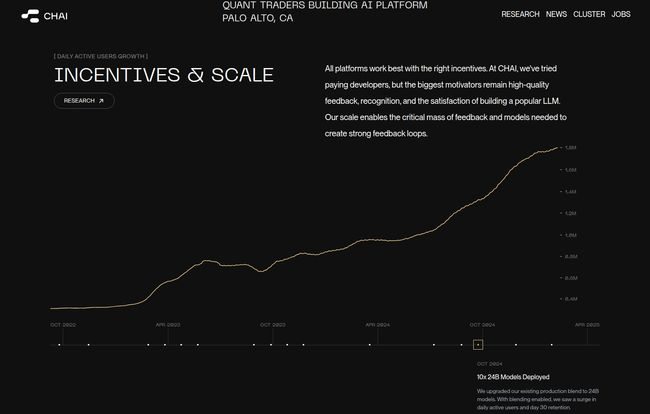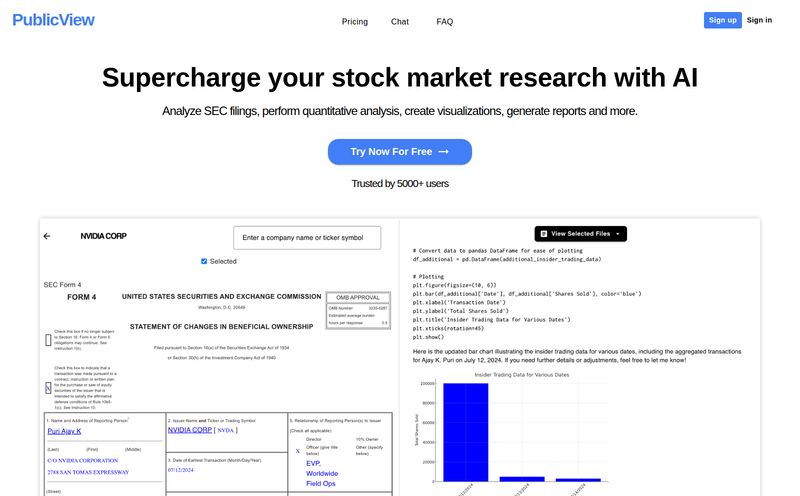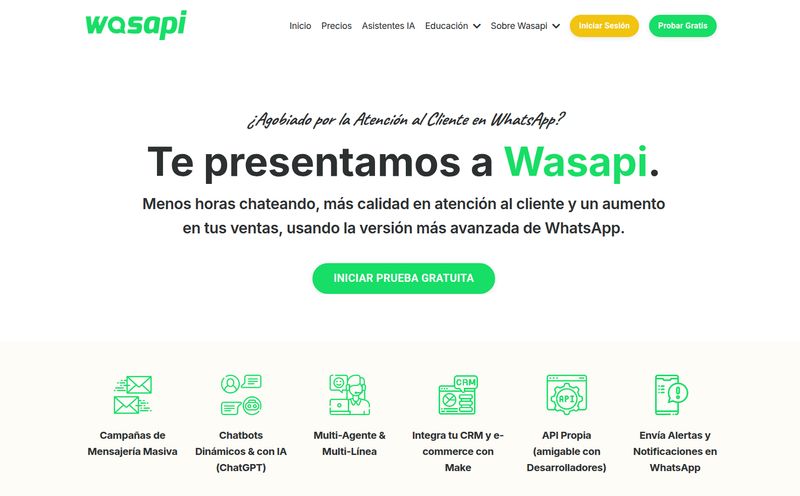Every week there’s a new tool that promises to write your emails, code your website, or summarize a two-hour podcast into three bullet points. And that’s cool. It's useful. But I've always felt the real 'killer app' for AI would be less about pure productivity and more about... well, us. About connection, entertainment, and a touch of delightful weirdness.
That's why I've been keeping a close eye on a platform called CHAI. If you haven't heard of them, you're probably not alone, but you're missing out on a quiet giant. While many companies were chasing the next big factual LLM, CHAI took a sharp left turn and focused on building a platform for social and entertaining AI. And the results? They speak for themselves.
We're talking about a platform that rocketed from obscurity to over 1.5 million daily active users in under two years. That’s not a typo. That’s the kind of viral growth that makes people in my line of work sit up and pay serious attention. So, what’s going on over at CHAI? Let's get into it.
So What Exactly is CHAI AI?
At its heart, CHAI is a platform designed to let everyday people build, interact with, and share their own conversational AI characters. Think of it less like a sterile Q&A bot and more like a creative studio for personalities. Their whole mission, in their own words, is to create AI that is “not only factually correct but also entertaining and social.”

Visit CHAI
This isn't just a hobbyist's playground, either. The platform is pulling in a reported $20 million in revenue, proving there's a serious market for AI that connects on a more human level. They’ve built a space where the goal isn't just to get an answer, but to have a conversation, to be entertained, and to create something unique. It’s a subtle but profound shift in how we think about interacting with artificial intelligence.
The Secret Sauce: A Look Under CHAI's Hood
Okay, so a million-plus daily users is impressive. But how do they do it? How do you support that many simultaneous, complex conversations without things grinding to a halt? The answer lies in a one-two punch of clever AI training and some seriously beefy hardware.
The Power of Mass Feedback: RLHF on Steroids
You’ve probably heard the term RLHF (Reinforcement Learning from Human Feedback) thrown around. It’s the technique OpenAI popularized with ChatGPT. The simple version? It’s like training a puppy. The AI does something, a human gives it a thumbs-up or thumbs-down, and the AI learns to do more of the good stuff. Simple, right?
Well, CHAI has taken this concept and put it on an industrial scale. With 1.5 million people chatting every day, they have one of the largest, most dynamic feedback loops on the planet. Every conversation, every interaction, is a data point that helps refine their models. They're also applying other proven techniques like Supervised Fine-Tuning (SFT) and clever LLM routing to make the AI characters more aligned with what their creators actually want. It's a system that gets smarter with every single user.
Horsepower for Days: The GPU Cluster
Now for the part that gets the tech nerds (like me) excited. You can't run all this on a couple of servers in a closet. CHAI has built a monster of an infrastructure. We're talking about a 14 exaflop GPU cluster. To put that in perspective, that’s a computer system capable of over 14 quintillion calculations per second. It’s... a lot.
Their setup includes over 5,000 high-end GPUs, including NVIDIA's A10G and L40S, and AMD's MI250X and MI300X chips. This digital powerhouse processes over 1.2 trillion tokens a day across more than 51,000 large language models. This isn't just a server rack; it's the digital equivalent of a nuclear power plant for conversations, ensuring that millions of users get a smooth, responsive experience.
The Big Wins for the CHAI Platform
Every platform has its strengths, but CHAI's are particularly compelling in today's market.
First and foremost is the massive user engagement. This isn't just a vanity metric. It's the engine of their entire improvement cycle. More users means more data, which leads to better AI, which attracts more users. It’s a virtuous cycle that's notoriously difficult to get started, but incredibly powerful once it's spinning.
Another smart move is their focus on creators. CHAI seems to understand that a platform is nothing without the people building on it. By creating incentives and feedback systems for developers and creators, they’re cultivating a loyal community that constantly pushes the boundaries of what's possible with their tools. It's a lesson a lot of other tech companies could stand to learn.
A Balanced View: The Potential Hurdles
No platform is perfect, and it would be dishonest to pretend otherwise. From what I can gather, CHAI runs on a relatively small, focused team. This can be a huge advantage—they're lean, fast, and not bogged down by bureaucracy. On the flip side, it could potentially be a bottleneck for rolling out major new features or expanding into different areas. It’s the classic startup tradeoff.
Some might also point to their deep focus on specific AI techniques as a potential risk. By mastering a particular niche of conversational AI, they've become incredibly good at it. But what happens if the industry pivots dramatically? I personally think specialization is a strength, but it's a valid question to consider. They're betting on a specific vision of AI's future, and so far, that bet is paying off handsomely.
So, How Much Does CHAI AI Cost?
Here's the million-dollar question. I went looking for a pricing page, and... nothing. Just a “Cannot GET /pricing” error. Now, dont panic. This is actually pretty common for platforms that are growing this quickly or that cater to a mix of individual users and larger developers. It usually means one of two things: they have a freemium model with in-app purchases, or they use custom pricing for bigger clients and want you to contact them directly. My advice? Download the app and see what the free experience is like. For anything more serious, you'll likely need to reach out to their team.
Conclusion: A New Direction for AI Interaction
So, where does that leave us? CHAI is, without a doubt, one of the most interesting stories in AI right now. They've sidestepped the main battleground of factual AIs and carved out a massive, thriving ecosystem in the world of social and entertainment bots. Their staggering user growth is proof that people are hungry for this kind of interaction.
With its powerful infrastructure, a clear research focus, and a dedicated user base that doubles as a quality-control army, CHAI isn’t just a fun app. It’s a serious platform that could very well be defining the future of how we interact with AI on a personal level. It's one I'll be watching closely. Very closely.
Frequently Asked Questions (FAQ)
What is CHAI AI?
CHAI is a platform focused on conversational AI, allowing users to create, share, and chat with unique AI characters. It emphasizes entertaining and social interactions over purely factual responses.
How many users does CHAI have?
As of late 2023, CHAI has a massive user base with over 1.5 million daily active users (DAU).
What technology does CHAI use?
CHAI employs a range of advanced AI techniques, most notably Reinforcement Learning from Human Feedback (RLHF) at a very large scale. It's all powered by a massive 14-exaflop GPU cluster with over 5,000 GPUs.
Is CHAI AI free to use?
The platform doesn't have a public pricing page, which typically suggests a freemium model where basic use is free but advanced features or higher usage may require a subscription or purchase. The best way to find out is to try the app.
Who is the founder of CHAI AI?
CHAI was founded by William Beauchamp, who serves as the company's CEO.
What makes CHAI different from other chatbot platforms?
CHAI's main differentiators are its massive scale (1.5M DAU), its specific focus on entertaining and social AI rather than just utility, and the powerful, custom-built infrastructure that supports these interactions.
References and Sources
- Official CHAI Research Website
- Understanding RLHF - Hugging Face Blog
- Further reading on AI platform growth trends from TechCrunch (general reference)



